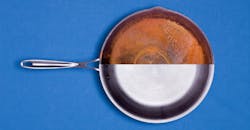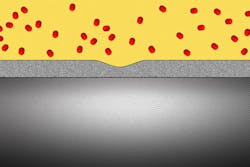Self-Healing Metals Help Fight Corrosion
Almost all metals, except gold, tend to oxidize when exposed to air and water. This interaction is what produces rust on iron, tarnish on silver, and verdigris on copper or brass—all of which weaken the metal over time, leading to cracks or structural failure. However, there is way to prevent corrosion. There are three elements that produce an oxide that serves as a protective barrier to prevent any further oxidation: aluminum oxide, chromium oxide, and silicon dioxide.
Researchers at MIT have found that when applied in thin layers, solid oxide protective coating can deform almost like a liquid, filling any cracks and gaps as they form. The thin coating layer can be instrumental in preventing leakage of tiny molecules that can penetrate through most materials, such as hydrogen gas that could be used to power fuel-cell cars, or the radioactive tritium (a heavy form of hydrogen) that forms inside the cores of nuclear power plants.
Aluminum oxide, when used as a thin-layered coating material, has a liquid-like flowing behavior, providing a strong and flexible coating material. (Image courtesy of MIT)
Understanding Corrosion Resistance
The research team is led by MIT graduate student Yang Yang. The team also includes research affiliate Akihiro Kushima at MIT, Weizhong Han at Xi’an Jiaotong University in China, and Huolin Xin at Brookhaven National Laboratory. The work was supported by the National Science Foundation.
The researchers are using highly specialized instruments to observe in detail the surface of metals coated with protective oxides to see what happens when they are exposed to an oxygen environment and placed under stress. Ju Li, is a professor of nuclear engineering and science and of materials science and engineering at MIT and senior author of a paper describing the new finding, published in the journal Nano Letters. “We were trying to understand why aluminum oxide and silicon dioxide are special oxides that give excellent corrosion resistance,” Li says.
The team used a modified version of transmission electron microscopes (TEMs), an environmental TEM (E-TEM) that, instead of operating in a vacuum, allows the sample to be studied in the presence of gases or liquids. The E-TEM was used to study the process that can lead to a type of failure known as stress corrosion cracking.
If not protected, metal under stress from extreme pressures, such as inside a reactor vessel, can corrode quickly once exposed to a superheated steam environment. Even with a solid protective layer cracks can form, allowing oxygen to enter bare metal surfaces in between the metal grains, causing further corrosion and structural failure. “We want an oxide that is liquid-like and crack-resistant,” Yang explains.
A thin layer of aluminum oxide separates oxygen gas (right) and two aluminum metal grains (left). As the material is stretched, the oxide layer elongates. (Image courtesy of MIT)
Applying Protective Coatings
Aluminum oxide, when used as a thin-layered coating material, has a liquid-like flowing behavior. The layers need to be 2 to 3 nanometers thick. Using the specialized E-TEM instrument helped the team make this discovery. The device setup at Brookhaven National Laboratory is one of only 10 in the world.
When the aluminum oxide is coated onto a surface of a bulk piece of aluminum, the coating flows like a liquid, providing a protective layer. Normally, at thicker layers, the layers would shatter under stress. However, due to the thin-layered application it is almost as deformable as a comparably thin layer of aluminum metal—a layer much thinner than aluminum foil. Inside the E-TEM setup, the researchers demonstrated the oxide coating could be stretched to more than double its length without causing any cracks to open up.
“People can’t imagine that a metal oxide can be ductile,” Yang says, referring to a metal’s ability to be deformed. For example, sapphire is a form of exactly the same material—aluminum oxide—but its bulk crystalline form, while making it a strong material, also makes it extremely brittle.
The self-healing coating could have many potential applications, Li says, noting the advantage of its smooth, continuous surface without cracks or grain boundaries that could penetrate into the material.


